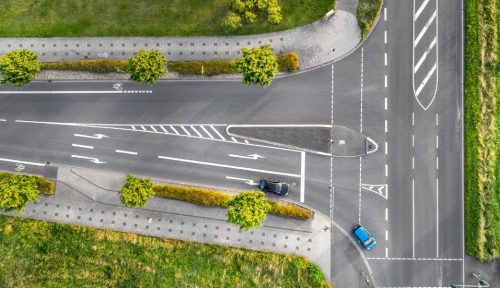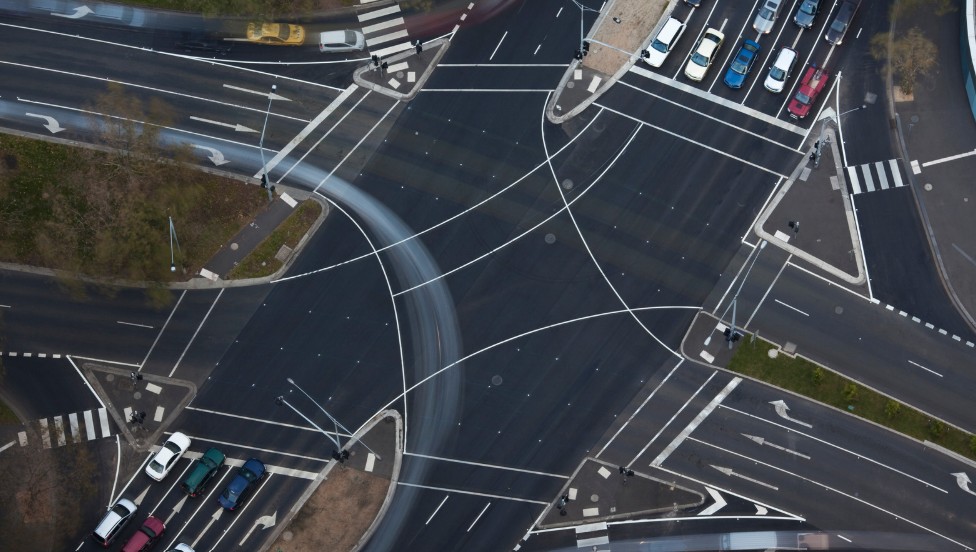Table of Contents
Unmarked crossroads can be a confusing and potentially hazardous part of driving, especially for new or inexperienced drivers.
Unlike marked junctions, these crossroads lack traffic lights, road markings, or signs that indicate who has the right of way.
This absence of clear direction means that drivers must rely on general road rules, awareness, and common sense to determine priority.
In the UK, the Highway Code provides guidance, but it does not explicitly define who has priority at an unmarked crossroads.
This uncertainty can lead to hesitation, misjudgments, and even collisions. Understanding how to approach these junctions safely is essential for all drivers to prevent accidents and maintain smooth traffic flow.
This guide will explore what unmarked crossroads are, how they differ from marked junctions, and the best practices for navigating them safely on UK roads.
What Are Unmarked Crossroads?

Unmarked crossroads are junctions where no road signs, signals, or markings indicate priority.
These are commonly found in residential areas, rural roads, and less-trafficked locations where authorities have not deemed additional signage necessary.
Drivers approaching these junctions must rely on caution, observation, and sound judgment to determine the right of way.
Unlike controlled intersections, unmarked crossroads do not have clear priority rules, increasing the potential for confusion among motorists.
This makes it essential for drivers to approach slowly, assess other road users’ movements, and be prepared to yield when necessary.
Cyclists, pedestrians, and vehicles arriving simultaneously must navigate these junctions with mutual awareness and cooperation.
Understanding how to safely approach and proceed through unmarked crossroads is vital for reducing accident risks and ensuring smooth traffic flow. The UK Highway Code provides guidance on handling such situations responsibly.
What Are the Characteristics of Unmarked Crossroads?
Unmarked crossroads share common traits that distinguish them from controlled junctions. Their lack of clear priority markings makes careful driving essential.
Key characteristics include:
- No road markings: There are no stop lines, give-way lines, or directional arrows.
- Absence of traffic signs: No “Give Way” or “Stop” signs define the priority.
- No traffic lights: Drivers must rely on judgment rather than signal control.
- Higher risk of confusion: The absence of guidance can lead to uncertainty among drivers.
- Common in low-traffic areas: Found mainly in rural roads and residential zones.
Due to these characteristics, drivers must proceed cautiously, observe others, and yield when necessary to prevent accidents.
How Does Unmarked Crossroads Differ from Marked Crossroads?

Unmarked and marked crossroads serve the same purpose allowing traffic from different roads to intersect, but they differ in control, priority rules, and overall safety.
Marked crossroads provide clear guidance to drivers, while unmarked crossroads require greater judgment, caution, and awareness of other road users. The Key differences are:
Road Markings
- Marked Crossroads: Have visible stop lines, give-way lines, and directional arrows to help drivers understand right-of-way.
- Unmarked Crossroads: Lack any visible road markings, requiring drivers to judge priority based on traffic flow and surroundings.
Traffic Signs
- Marked Crossroads: Display “Give Way” or “Stop” signs, clearly directing which road users have priority and who must yield.
- Unmarked Crossroads: Have no signage, so drivers must assess priority independently by observing approaching vehicles and pedestrians.
Traffic Flow Control
- Marked Crossroads: Often controlled by traffic lights, stop signs, or other road signs to manage the orderly movement of vehicles.
- Unmarked Crossroads: Rely on driver discretion, careful observation, and mutual understanding to prevent conflicts or accidents.
Priority Rules
- Marked Crossroads: Drivers follow specific rules dictated by road signs and markings, reducing uncertainty about who goes first.
- Unmarked Crossroads: Typically follow the “priority to the right” rule, but this is not legally enforced, meaning extra caution is needed.
Because unmarked crossroads lack clear control measures, they carry a higher risk of confusion, hesitation, and potential accidents, making defensive driving essential in these situations.
What Does the UK Highway Code Say About Priority at Unmarked Crossroads?

The UK Highway Code does not specify a strict rule for priority at unmarked crossroads. Instead, it provides general guidance on safe driving practices when approaching such junctions.
Key Guidance from the Highway Code
- Proceed with Caution: Always slow down when approaching an unmarked crossroads and be prepared to stop.
- Observe Other Road Users: Look for vehicles, cyclists, and pedestrians from all directions before proceeding.
- Use Common Sense and Courtesy: If unsure, yield to avoid confusion or potential collisions.
- Priority to the Right: Although not a strict rule, it is commonly understood that vehicles coming from the right generally have priority.
Since unmarked crossroads do not have defined right-of-way regulations, drivers must rely on defensive driving techniques and clear communication with other road users to determine priority safely.
Who Has Priority at an Unmarked Crossroads?
At an unmarked crossroads, no one has legal priority, so all drivers must approach with caution and be prepared to stop.
The UK Highway Code advises slowing down and observing other road users carefully, as there are no road signs or markings to dictate the right of way.
While the common practice is to give priority to vehicles coming from the right, this is not a legal requirement.
Several factors can influence priority, such as road size and traffic flow, with larger roads sometimes having unofficial priority.
Additionally, vehicle speed and positioning can affect decisions, as hesitant drivers may unintentionally yield.
In such situations, defensive driving is essential. If uncertain, it’s always safer to yield than assume priority.
Navigating unmarked crossroads requires careful judgment, respect for other road users, and cooperative driving to ensure safety.
What Should You Do When Approaching an Unmarked Crossroads?

When approaching an unmarked crossroads, caution and awareness are key to avoiding potential collisions.
Since there are no traffic lights, signs, or road markings to indicate priority, drivers must use judgment and defensive driving techniques to navigate safely.
Best Practices for Approaching an Unmarked Crossroads
- Reduce Speed: Always slow down well before reaching the junction. This allows time to assess the situation and react appropriately.
- Look in All Directions: Check for approaching vehicles, cyclists, and pedestrians from all sides of the intersection.
- Observe Other Drivers’ Behaviour: Watch for signs of hesitation or movement that indicate what another driver might do.
- Be Prepared to Yield: If another vehicle approaches from the right, it is generally safer to give way. However, do not assume they will automatically take priority.
- Use Eye Contact and Signals: If necessary, make eye contact with other drivers and use indicators to show your intentions.
- Proceed with Caution: If the junction is clear, move forward slowly while staying alert to any sudden movements from other road users.
By staying patient, avoiding assumptions, and prioritising safety, drivers can reduce risks and navigate unmarked crossroads with confidence.
Are There Exceptions to the Priority Rules at Unmarked Crossroads?
While the general rule at unmarked crossroads suggests giving priority to vehicles on the right, certain factors can override this assumption. One major exception is the type of road leading to the crossroads.
For instance, if one road appears to be a main road while the other is a minor or side road, vehicles on the main road are usually expected to proceed first, even if they are coming from the left.
Similarly, larger or faster-moving roads tend to have an unofficial priority over smaller, quieter roads.
Another exception applies to emergency vehicles. If an ambulance, fire engine, or police car approaches with sirens and flashing lights, all drivers must yield, regardless of direction.
Road conditions can also affect priority. If a driver’s visibility is obstructed due to poor weather, parked cars, or road bends, it may be safer for all vehicles to slow down and negotiate the crossing individually rather than strictly following the right-of-way rule.
Common sense and caution should always take precedence over informal rules.
How Can You Reduce the Risk of Accidents at Unmarked Crossroads?

Navigating unmarked crossroads requires a proactive approach to safety.
Without road signs or markings to dictate priority, drivers must stay alert and anticipate the actions of others to minimise the risk of accidents. Here are the key safety measures to reduce accidents:
Slow Down in Advance
Approach the crossroads with caution to ensure you have enough time to react. Reducing speed helps you stay prepared for any unexpected situations.
Check Blind Spots
Always look for vehicles, pedestrians, or cyclists hidden by obstructions like parked cars. Ensure you have full visibility from all directions.
Use Defensive Driving Techniques
Be prepared for other drivers to ignore the right of way and always be ready to stop. Anticipating other drivers’ actions can prevent accidents.
Establish Eye Contact with Other Drivers
Make eye contact to signal your intentions clearly, reducing confusion about who should go first. This can help avoid misunderstandings at junctions.
Stay Aware of Pedestrians and Cyclists
Always watch out for vulnerable road users, especially at unmarked crossroads. They might be harder to spot and have the right of way.
By following these precautions and prioritising safety over speed, drivers can significantly reduce the chances of a collision at unmarked crossroads.
What Happens If an Accident Occurs at an Unmarked Crossroads?
Accidents at unmarked crossroads can be complicated due to the lack of clear priority rules.
With no traffic signs or markings, determining fault often depends on evidence and witness accounts. It’s important to follow specific steps after an accident to ensure safety and clarity.
Key Steps to Take After an Accident
- Ensure Everyone’s Safety: Check for injuries and call emergency services if necessary.
- Move Vehicles If Possible: Relocate vehicles to a safer area to prevent further accidents.
- Gather Evidence: Capture photos of the scene, vehicle positions, damage, and visibility issues.
- Speak to Witnesses: Collect witness statements and contact details.
- Exchange Information: Swap insurance and contact details with all involved drivers.
- Contact Your Insurance Provider: Report the incident promptly with all supporting evidence.
Determining Fault
Fault is usually based on driver behaviour, considering:
- Who entered the junction first
- Whether a driver observed other vehicles or failed to slow down
- Evidence of reckless driving or failure to yield
If fault cannot be determined easily, insurance companies may assign shared responsibility. Defensive driving and following safe approaches can help prevent such situations.
Do Driving Theory Tests Cover Unmarked Crossroads?

Yes, unmarked crossroads are covered in the UK driving theory test, as they are an important aspect of road safety and driving awareness.
Both the multiple-choice questions and the hazard perception test include scenarios related to unmarked junctions.
Learner drivers are expected to understand how to approach these junctions safely, including:
- Recognising an unmarked crossroads and the potential risks.
- Understanding the right-of-way principle (though not legally enforced, priority to the right is commonly followed).
- Knowing when to yield based on road conditions and driver behaviour.
Practical driving tests may also include navigating unmarked crossroads in real-life settings.
Examiners observe how candidates approach, assess, and proceed at these junctions, ensuring they demonstrate proper caution and decision-making skills.
Conclusion
Understanding who has priority at an unmarked crossroads in the UK is crucial for safe and responsible driving.
Unlike marked junctions, these crossroads lack clear signage, requiring drivers to rely on awareness, communication, and defensive driving techniques.
While the “priority to the right” rule is a common guideline, the UK Highway Code does not specify a strict legal priority.
As such, caution, patience, and good judgment are essential when approaching these intersections.
By following safe driving practices, reducing speed, and remaining alert, you can navigate unmarked crossroads confidently while minimising risks.
FAQs
What is the best way to approach an unmarked crossroads safely?
Always reduce your speed, observe other road users carefully, and be prepared to stop immediately if necessary.
Are cyclists and pedestrians subject to the same priority rules at unmarked crossroads?
Yes, but drivers should always give way to vulnerable road users like pedestrians and cyclists, especially when in doubt.
What happens if two vehicles arrive at an unmarked crossroads at the same time?
In general, the vehicle on the right has priority, but drivers should communicate clearly and proceed with caution always.
Do unmarked crossroads have specific rules for rural vs. urban areas?
While the same principles apply, rural crossroads may have lower visibility and require extra careful driving attention.
Can local councils install priority signs at previously unmarked crossroads?
Yes, if a junction becomes hazardous, councils may introduce road markings, traffic lights, or additional safety signage.
Is failure to give way at an unmarked crossroads a traffic offence?
While not a specific offence, causing an accident due to failing to yield could result in penalties or legal action.
How can learner drivers prepare for handling unmarked crossroads?
Practising in low-traffic areas and understanding the Highway Code rules can help build confidence and driving awareness.




